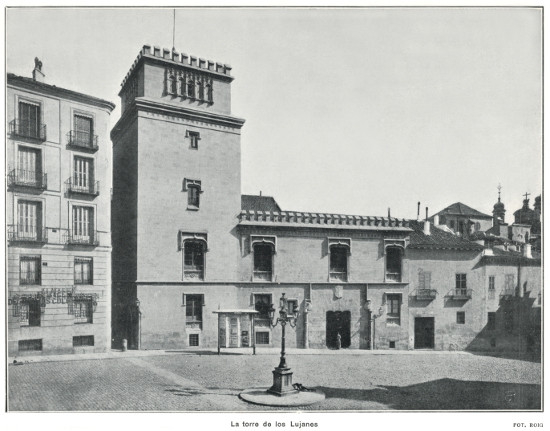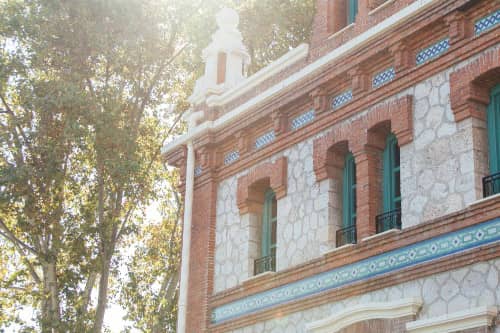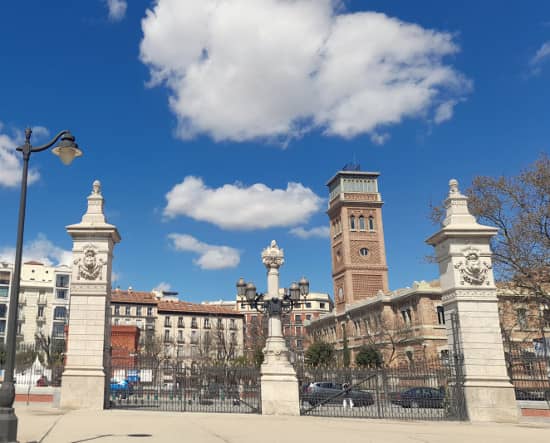
Neo-Mudejar architecture in Madrid
Neo-gothic, neoclassical, neo-roman, neo-Renaissance… In the 19th and 20th centuries, all over Europe, people were returning to the architecture of the past, recalling the origins of nations and adapting modern techniques to traditional aesthetics, Spain recovered the mudejar style as you can appreciate in the neo-mudejar architecture in Madrid.
This was a period when European countries wanted to write their history and illustrate their identity, and Spain was focusing on the neo-Mudéjar style: a return to Al-Andalus, nearly 800 years of Arab emirate on the Iberian peninsula.
Indeed, this past marks a strong difference between Spain and its northern neighbors, and allowed the Spanish nation to assert its aesthetic specificity in architecture.

But what is “Mudéjar”?
“Mudéjar” is a term that refers to Christian architecture (Roman, Gothic, Renaissance…) mixed with Muslim techniques and forms. The term was first used in the 19th century and is the pride of Spain, melting Arab and Iberian influences from the Middle Ages as has rarely been the case in Europe.
Mudejar architecture can be described in several ways. First and foremost, the materials used are soft and easy to work with, such as brick, ceramics and stucco, sometimes mixed with stone. There are also Arab elements in the structure of the building and in the interior decor: wooden coffered ceilings, ceramic ornamentation and geometric patterns. Finally, one of the easiest visual elements to spot is that of the arches: broken, poly-lobed, round headed… The shapes of arcades and openings in Mudéjar architecture are highly significant.
But these characteristics alone are not enough. They just describe the Arab style, known as “Moorish” on the peninsula, and to speak of “Mudéjar”, they have to be mixed with Christian building plans, showing above all the fusion of several cultures.

A return to history
Although there are very few examples of Arab architecture in Madrid, as in Andalusia, for example, neo-Mudejar architecture has been present in the capital since the 19th century. The desire to define a Spanish national style has prompted architects to return to Mudéjar in the construction of railway stations, theaters, factories, schools and even cemeteries throughout the country, mixing “Western” structures with Moorish decor and materials. The malleability of brick and its aesthetic possibilities were also rediscovered at this time, enabling the construction of functional factories at the peak of industrialization.
In Madrid, it was the architects Agustín Ortiz Villajos and Emilio Rodríguez Ayuso who made a name for themselves from 1860 for their interest in neo-Mudéjar, and were responsible for the creation of many buildings still standing today.
This is the case, for example, of the former Matadero slaughterhouses, now a cultural center, whose administration (“Casa del Reloj”) is a fine example of the use of Moorish structural features in a rather European aesthetic, but also of the Casa Arabe, the current name of the Aguirre schools, where Emilio Rodríguez Ayuso demonstrates the decorative possibilities offered by brick on a highly worked façade, while also offering a very modern crystal watchtower.

Meanwhile Francisco García Nava, for his part, built several churches using Mudéjar techniques, as well as the entrance of the Almudena cemetery, showing the transition to Modernist and Art Deco aesthetics, which took over Madrid in the 1930s.
So whether you’re visiting the churches of San Fermin or Santa Cruz, going to see a show at Las Ventas arenas or passing through the Chambéry water tower district, neo-Mudejar architecture is very much in evidence in Madrid’s capital, reminding us of the Iberian Peninsula’s past and the cultural exchanges that contribute to its richness.
The city of Madrid indeed offers cosmopolitan architecture, its history having crossed Al-Andalus, the Christian arrival, the Habsburg dynasty, the Enlightenment period and the Romantic era, culminating today in a unique landscape.
To discover and understand all these trends, come and visit the city with us by booking our free tour Madrid .